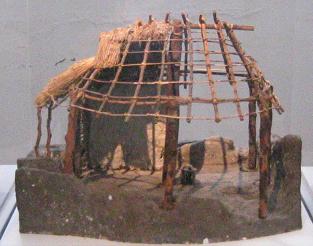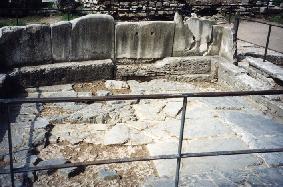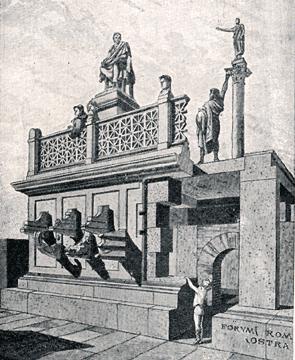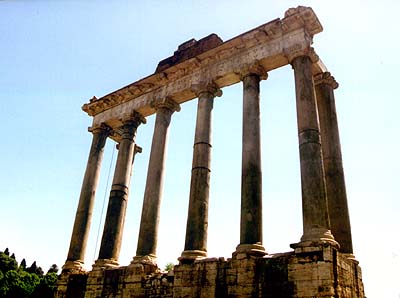|
|
 |
|
The Roman Forum |
|
written
by justinvf / 09.14.2005 |
|
|
| |
Introduction |
| |
| |

|
| Personal Photo |
| Etruscan Hut |
| This is what the earliest settlements in the forum area would have looked like.
Later this round shape is seen in the Temple of Vespa. |
| |
|
| |

|
|
| Lapis Niger |
| This is one of the oldest and mythical locations of the Forum. |
| |
|
| |

|
|
| The Rostra |
| This shows an artists conception of the original rostra. |
| |
|
| |

|
|
| Temple of the Vestal Virgins |
| This displays the remains of the temple, reconstructed from images found on old coins. |
| |
|
| |

|
|
| Temple of Saturn |
| Here are the present ruins of the once gigantic Temple of Saturn |
| |
|
Introduction
The Fora Romana was symbolically the center of Roman government and as such, the perfect location for emperors to erect buildings with a propagandistic intent. In looking at the sites today, though mainly in ruins, one can still feel the overpowering influence they exert. To an ancient Roman the overpowering structure of the forum would have left the observer with little doubt of Rome’s supremacy, humbling him before Rome’s grandeur. With both religious and governmental buildings placed in the Forum, the location served as a center to all that represented Rome. Buildings erected within the Forum therefore served as central symbols of Rome, and due to this politicians could shift perception of the empire by erecting monuments in the Forum which gave the location immense political importance.
Beginnings
The original inhabitants of Rome settled on the Palatine. This was a prime location as it was close to the Tiber, but still elevated as to protect the settlement from the rivers frequent flooding and foreign attack. Upon original inhabitation the area of the forum was initially a swamp, and its use was mainly as a necropolis, with tombs dating from the 10th century BC. Eventually however, the room on hills was at a premium, and thus some inhabitants started to move down into the Forum, living in the round Etruscan style huts. The first step towards making the Forum what it is today however was undertaken around the 6th century BC, when the Tarquin kings, with knowledge of drainage gained from the east, built the Cloaca Maxima, or great drain. This drained the inhospitable marsh, and along with an initial paving in that period, made the location well situated to become the center of an expanding Rome.
Structures
Pre-Imperial:
Though these buildings were originally created before imperial Rome the versions today, save the Lapis Niger, are usually reconstructions. This is due to fires which were dangerously common in Rome, as well as just general reconstructions by politicians wanting to show their benevolence and gain favor with the populace.
Lapis Niger
The Lapis Niger is an area of bluish grey stone, and its origins are permeated with myth. The commonly held belief is that it is the tomb of Romulus, while there are other opinions that it holds the tomb of the shepherd who discovered Romulus and Remus. There is no evidence of a tomb however, and thus it is somewhat of a mystery. While there is currently no definitive answer as to the area’s true purpose, within the vault beneath the marble slabs there in the earliest known Latin writing, dating from the 6th century BC. The writings apparently detail some sort of ritual and though the Lapis Niger has unclear origins, the presence of these writings makes it a very important monument.
Rostra
The Rostra is an elevated platform from which the early kings of Rome gave their speeches, an early example of the Forum as political center. Along its front one can see small square indentations, which are from occasions where the prows of enemy ships were stuck into the Rostra by the metal beams which ran down the hull. In this one sees the reoccurring Roman tradition of bringing symbols of conquests back to Rome in order to gain support for foreign campaigns, a practice which reached its height in the Triumph. The Roman conquerors needed these symbols of conquest in order to give the Romans a sense of accomplishment in waging wars which were often far detached from the lives of an average Roman and his security. This is also the location from which Marc Anthony gave his famous speech defending Caesar after his assassination.
Temple of the Vestal Virgins
The vestal virgin tradition was a sacred one to the Romans, with the vestals an icon of purity. Their charge was to keep the flame in the temple of Vesta from extinguishing, as Rome was supposed to be impervious as long as it remained lit. The appointment, which one gained in early childhood, was for thirty years, 10 spent learning the rituals, 10 spent performing them, and 10 spent teaching them to the next generation. During this period, strict chastity was required and if a virgin was even accused of chastity she would be buried alive unless a sign from Vesta herself was observed in her defense. The male would be flogged to death.
The temple, of which only three columns have been reconstructed, was circular in shape, a style inherited from the round shape of the early Etruscan huts in the area. Along the top there are icons representing various acts of sacrifice. Inside the temple there were deep pits which held the offal left over from the animal sacrifices performed in the temple. Also in the temple there was a cache holding various treasures, one of which legend says to be the Palladium brought over by Aenid when he fled Troy.
Temple of Saturn
The temple of Saturn is second only to the temple of Vesta in age, with its origins dating back to the Tarquin kings. As was mentioned, the version of the temple that stands today was an imperial rebuild and the massive granite portico that remains dates to the fourth century AD. In addition to serving as a temple, it was also the treasury of empire, and a location for the posting of public documents. Within the temple was a statue of Saturn brought out for Triumphal processions.
|
| |
|
| |
|
|
 |
|



